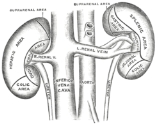
Renal vein
Encyclopedia
The renal veins are vein
s that drain the kidney
. They connect the kidney to the inferior vena cava
.
It is usually singular to each kidney, except in the condition "multiple renal veins".
It also divides into 2 divisions upon entering the kidney:
Often, each renal vein will have a branch that receives blood from the ureter.
Because the inferior vena cava
is not laterally symmetrical, the left renal vein often receives the following veins:
This is in contrast to the right side of the body, where these veins drain directly into the IVC.
(RVT) and nutcracker syndrome
(renal vein entrapment syndrome).
Vein
In the circulatory system, veins are blood vessels that carry blood towards the heart. Most veins carry deoxygenated blood from the tissues back to the heart; exceptions are the pulmonary and umbilical veins, both of which carry oxygenated blood to the heart...
s that drain the kidney
Kidney
The kidneys, organs with several functions, serve essential regulatory roles in most animals, including vertebrates and some invertebrates. They are essential in the urinary system and also serve homeostatic functions such as the regulation of electrolytes, maintenance of acid–base balance, and...
. They connect the kidney to the inferior vena cava
Inferior vena cava
The inferior vena cava , also known as the posterior vena cava, is the large vein that carries de-oxygenated blood from the lower half of the body into the right atrium of the heart....
.
It is usually singular to each kidney, except in the condition "multiple renal veins".
It also divides into 2 divisions upon entering the kidney:
- the anterior branch which receives blood from the anterior portion of the kidney and,
- the posterior branch which receives blood from the posterior portion.
Often, each renal vein will have a branch that receives blood from the ureter.
Asymmetry
Because the inferior vena cava is on the right half of the body, the left renal vein is generally the longer of the two.Because the inferior vena cava
Inferior vena cava
The inferior vena cava , also known as the posterior vena cava, is the large vein that carries de-oxygenated blood from the lower half of the body into the right atrium of the heart....
is not laterally symmetrical, the left renal vein often receives the following veins:
- left inferior phrenic veinInferior phrenic veinThe Inferior Phrenic Veins drain the diaphragm and follow the course of the inferior phrenic arteries;* the right ends in the inferior vena cava;* the left is often represented by two branches,** one of which ends in the left renal or suprarenal vein,...
- left suprarenal vein
- left gonadal veinGonadal veinIn medicine, gonadal vein refers to the blood vessel that carrying blood away from the gonad toward the heart.* Females : ovarian vein* Males : testicular vein...
(left testicular vein in males, left ovarian vein in females) - left 2nd lumbar vein
This is in contrast to the right side of the body, where these veins drain directly into the IVC.
Pathology
Diseases associated with the renal vein include renal vein thrombosisRenal vein thrombosis
Renal vein thrombosis is the formation of a clot or thrombus obstructing the renal vein, leading to a reduction in drainage of the kidney.-Presentation:This thrombosis can lead to imbalances in blood clotting factor...
(RVT) and nutcracker syndrome
Nutcracker syndrome
In medicine, the nutcracker syndrome — is a clinically manifest variant of nutcracker phenomenon, renal vein entrapment syndrome, or mesoaortic compression of the left renal vein. It results most commonly from the compression of the left renal vein between the abdominal aorta and superior...
(renal vein entrapment syndrome).

